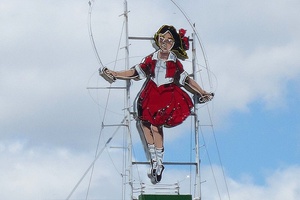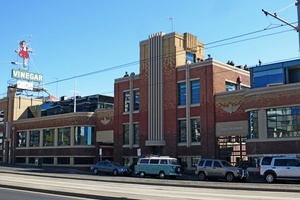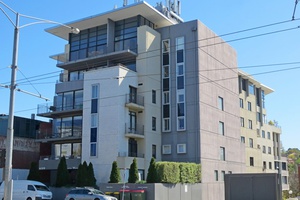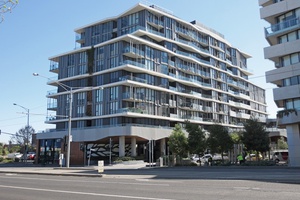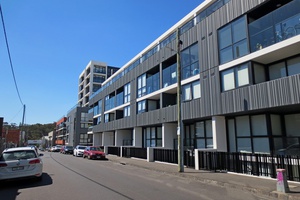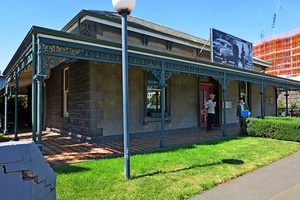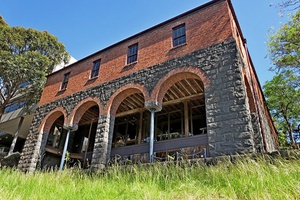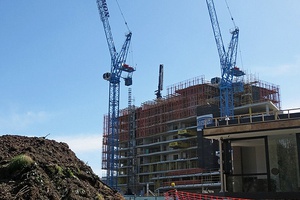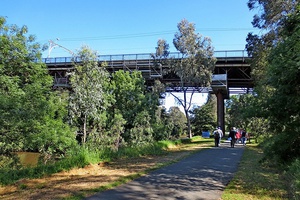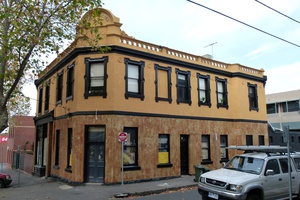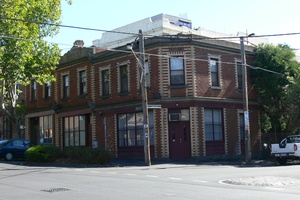This item is a part of these Tours
From Skipping Girl to Abbotsford Cool
Jump To TourThis record is a stop on a tour which goes to other places. Pick up the tour by jumping to it from here. Check the map to see where it goes. You can jump back to this place later.
This item is a part of these Themes
Industry
Jump To ThemeThere are other records in this place with a similar theme. Explore this theme by jumping to it from here. You can jump back to this piece later.
Other content from this author
-
Start: Walmer St Bridge
This bridge, although it also provides pedestrian access between Abbotsford and Studley Park, was primarily constructed to transport fresh water from a reservoir on the Studley Park Hill to the Botanical Gardens. Unfortunately just after completion the record-breaking flood of July 1891 destroyed the bridge, and it had to be re-built. Full tour details: http://collingwoodhs.org.au/participate/walks-talks/from-skipping-girl-to-abbotsford-cool-2012/
CollingwoodHS
-
1. Graham's Brewery
1. Graham’s Brewery, Shamrock Brewery, Nycander Vinegar Company, MFB Training College. Image: Thomas Graham’s Simpson’s Road Brewery between 1865 and 1871.
CollingwoodHS
-
2. Flockhart Reserve
Flockhart Reserve is located at the north end of Flockhart Street, which was at various times occupied by a tannery, clay pits, brick works and market gardens. The 1858 map shows clay pits on both sides of the street. Brickmaker Joseph Shirley built the Brickmaker’s Arms in Victoria Street in 1853, providing accommodation for his employees. In the mid-nineteenth century, brickmaking was mainly a small scale and sometimes seasonal business.
CollingwoodHS
-
3. Grosvenor Street
Part of the subdivision of the large Grosvenor Estate belonging to Mr Norton’s Grosvenor Lodge (previously and later known as Yarra Grange) which was sold from late 1858 onwards. Some riverside allotments were still quite large, while those in Grosvenor Street were mostly 40 ft by 99 ft (dimensions still existing in remaining properties on the west side). The west side developed as mainly residential, although the width of the plots meant that small businessmen such as cab owners, cabinet makers and a dairyman could ply their trades from home, while from 1870 a pub supplied conviviality after work. On the east side there were only three residences near Victoria Street, and one associated with the tannery towards the river; the rest was industrial. William Melchior was another brickmaker who remained in the area until his death (in 1898); he lived at number 25 and had his brickworks on the opposite side of the street.
CollingwoodHS
-
4. Australian Asbestos Company
Erected 1888. Henry Walker was one of the directors of the company. The building was taken over by Phoenix Biscuit Company about 1910.
CollingwoodHS
-
5. Victoria Ice Company
Constructed 1889-90. Cnr Southampton Crescent and Grosvenor St. Taken over by the Phoenix Biscuit Co about 1910.
CollingwoodHS
-
6. Phoenix Biscuit Company
Constructed around 1925 on the southwest corner, a single story building with a curved parapet and the company initials in low relief and believed to have been used as their main office. The brickwork has unfortunately been painted over. Phoenix Biscuits, later Weston’s, was associated with Abbotsford for many decades.
CollingwoodHS
-
7. Site of Grosvenor Hotel
37 Grosvenor St., Grosvenor Hotel was a two-storey brick building with 12 rooms, which operated from 1870 to 1918.
CollingwoodHS
-
8. 21 Grosvenor St.
Victorian house, later altered. Residence for many years of Henry Zeigenbein, a cab proprietor. The side driveway would have been convenient for this work.
CollingwoodHS
-
9. 19 Grosvenor St.
Double fronted weatherboard house, built prior to 1864. Owned and occupied by Samuel Cane, a cooper. The oldest surviving building in Grosvenor St. At 13 Grosvenor St. is a 1867 double fronted brick house. Originally just two rooms, it has a skillion-roofed rear section. Tuck-pointed brickwork has been overpainted. Bluestone windowsills. Veranda posts and balustrade are not original. Lived in by Edward Muller, a brickmaker, for over 50 years. Second-oldest extant house in the street, a rare surviving example of a modest worker’s cottage in this district.
CollingwoodHS
-
10. 13 Grosvenor St.
1867 double fronted brick house. Originally just two rooms, it has a skillion-roofed rear section. Tuck-pointed brickwork has been overpainted. Bluestone windowsills. Veranda posts and balustrade are not original. Lived in by Edward Muller, a brickmaker, for over 50 years. Second-oldest extant house in the street, a rare surviving example of a modest worker’s cottage in this district.
CollingwoodHS
-
11. Terminus Hotel
This building was erected for brickmaker and landowner Robert Dehnert in 1867. Called the Brickmaker’s Arms until 1923, its new name would have been a reference to the cable tram route which terminated just before the river. (The cable tram shed was on the other side of Victoria Street). In the 1930s when the Moderne craze swept through Melbourne, the hotel was remodelled in distinctive style.The hotel was closed in 2012 for renovation and reopened in 2017. The photo below was taken in September 2018.
CollingwoodHS
-
12. Victoria St., site of Green Square
Green Square, a Salta Property development – you too could be cool – just buy an apartment here. Augustus Fritsch the brickmaker and Henry Walker the candle-maker were located in this area in the nineteenth century. Sam Tarascio senior, a Sicilian migrant, founded Salta 30 years ago and he was later joined by his son Sam junior. The company, which is now one of Australia’s largest privately-owned companies, developed the Victoria Gardens precinct in the 1990s.
CollingwoodHS
-
13. [627] Victoria St. Brewery/Vinegar/Skipping Girl
This is the site of the front of Graham's brewery which was eventually bought by Messrs Boyd and Head of the Crown Brewery in Fitzroy, enlarged and expanded, and renamed the Shamrock Brewery, which was one of the firms which amalgamated in 1907 to form Carlton and United Breweries. It was re-built as an imposing tall brick structure around 1890, and was later used by Nycander Vinegar Company. The famous skipping girl illuminated sign was erected on top of it in 1936. After the factory was demolished ca. 1968, the Melbourne Fire Brigade Training College occupied this site until demolished in turn to make way for a new development.
CollingwoodHS
-
14. Former Crusader Plate
651-653 Victoria St. - Crusader Plate was built 1937 as an extension to the neighbouring works to the east and designed in sympathy with it. The use of colour graduated brickwork (dark brown/red/warm cream/light cream) may be unique in Melbourne. The Skipping Girl is now located on the roof of this building. Part of the rear was demolished and new office buildings have been added.
CollingwoodHS
-
15. 655 Victoria St.
Former Handley and Tilley built 1929. The company was involved in the manufacture of aluminium plate. Now “Skipping Girl Apartments”. A lovely building, described as ‘an extraordinarily confident expression of the Moderne idiom’ with a strong vertical central element and symmetrical curves to either side. The whole complex is an excellent example of the Moderne style as applied to industrial architecture, and is of state significance. Cross to the other side of Victoria St for a better overall view.
CollingwoodHS
-
19. Haven development site: Acacia Place
Former Honeywell site, former site of Henry Walker’s soap factory. A John Boehme had a tallow works on this site prior to Walker taking over in the 1860s. Henry Walker was another Yorkshireman, the proprietor of the Hobson’s Bay Soap and Candle Company, and became a long-serving Collingwood councillor, occupying the mayoral seat in 1873, 1875, 1878-79, 1880-81, and 1887-88. He was also a Justice of the Peace and chairman of the local bench for many years. He held a long lease on this land which was owned by Peter Nettleton. At his death in 1900 the property included a brick house, two old weatherboard cottages, and an area ‘let as a Chinese garden’ (i.e. market garden conducted by Chinese people).
CollingwoodHS
-
10. East side Grosvenor St.
East side Grosvenor St. A huge building site (Pro-Build / Salvo Property Group) going through to Flockhart Street. The Salvo Property Group bought the site in 2008.(Executive chairman Mario Salvo started as a mechanic then took on a car hire business which he developed into the third largest car hire company in Australia and New Zealand. His son Andrew also works for the privately owned family business). The development will consist of five buildings ranging from five to ten storeys with a total of 450 apartments. 603 Victoria St. Site of the house lived in by Robert Dehnert until his death in 1920. Dehnert owned much of the land in Flockhart Street. He built the Grosvenor Brewery to the west of the house for his son Reinhold to run. Most of his children lived with him or in the Terminus Hotel. In 1954 two old bachelor sons, Alfred and Hermann, were still living in this house. Alfred made the news headlines when he died leaving money to his dog Bob (well, actually when you read the article, he left money for his dog to be cared for). The house was demolished in the 1990s.
CollingwoodHS
-
17. 663 Victoria St. Nettleton House
Peter Nettleton, a Yorkshireman, arrived in Melbourne in 1849 and was employed as a fellmonger until the discovery of gold when he went off to the goldfields where he met with some success. He married Mary Anne in December 1852 and around this time is believed to have bought the land in Portion 63 and returned to fellmongering. His property included five wooden cottages. This bluestone house was built in 1861-62. Nettleton died at his home in 1901 aged 77. His only living son Arthur drowned in the Yarra some weeks later; Mary Anne stayed in the house until her death in 1903. The house was a restaurant (Nettleton House) for some years after 1980 while the bluestone stables still house a cafe.
CollingwoodHS
-
18. Former Alma Wool Scouring works
Walk down between the buildings towards the river. Originally Peter Nettleton’s wool scouring works, Woolshed 1 and 2, and part of the wharf, remain. The three-storey woolshed was built around 1861. In 1870, Nettleton’s fellmongery was cleaning 3,000 sheepskins per week. A great quantity of animal remains were disposed of in the river creating water and air pollution, with many complaints about the noxious odours. In 1920 the business was acquired by the Alma Wool Scouring Company, which continued operations until 1980.
CollingwoodHS
-
19a. Haven development site & Sanctuary Apartments
Former Honeywell site, former site of Henry Walker’s soap factory. A John Boehme had a tallow works on this site prior to Walker taking over in the 1860s. Henry Walker was another Yorkshireman, the proprietor of the Hobson’s Bay Soap and Candle Company, and became a long-serving Collingwood councillor, occupying the mayoral seat in 1873, 1875, 1878-79, 1880-81, and 1887-88. He was also a Justice of the Peace and chairman of the local bench for many years. He held a long lease on this land which was owned by Peter Nettleton. At his death in 1900 the property included a brick house, two old weatherboard cottages, and an area ‘let as a Chinese garden’ (i.e. market garden conducted by Chinese people). The second photo of Sanctuary Apartments was take in September 2018.
CollingwoodHS
-
20. Victoria St Bridge
A bridge across this section of the Yarra had been discussed for some years, but owing to the need for four councils to agree, and the cost of the project, which would involve acquiring land, it was 1879 before serious plans were underway. Building commenced in 1882, partly on land owned by Peter Nettleton. Henry Walker donated 100 pounds towards the construction (the bridge was going to be good for business for both Walker and Nettleton). The bridge was officially opened in 1884. Unfortunately it soon became known as the suicide bridge, as its height made it ideal for that purpose.
CollingwoodHS
-
The Star Hotel
9-11 Peel St, Collingwood This hotel was built by Thomas Veal in 1868 and operated as a hotel until it was delicensed in 1928. The longest serving licensee & owner was Mrs Mary Maher from 1878 until 1889. Mary remained the owner until well into the twentieth century. After delicensing the hotel was used for residential purposes and in the 1930s it accommodated up to 56 unemployed men. It was saved from oblivion when it first became the Clichy Restaurant in 1977, followed by Jack's Bar and then the Gay Trades Bar until 2007. It has since under gone refurbishment and is once again open as a café. The Star is a an attractive corner building, which incorporates various architectural references to its name in the exterior decoration.
CollingwoodHS
-
Barnard's Hotel
Barnard's Hotel was built in 1869 and operated until it was delicensed in 1914. The building still exists today. William Barnard was a baker and in 1869 he built three brick shops, the corner one became the hotel and he continued his business as a baker, pastrycook and confectioner until his death in 1902. James Condon and his wife Ann ran the hotel and bakery business until the hotel was closed by the Licenses Reduction Board in 1914. The hotel and adjacent shops form a pleasing example of bi-chrome brickwork which was a style used on the Collingwood Slope from the towering Yorkshire Brewery to small cottages.
CollingwoodHS
-
Clifton Hill Hotel
The Clifton Hill Hotel was built by Frederick Warming in 1884, whose name can still be seen in the pediment. The hotel continues to operate today. It is a two-storeyed Italianate stuccoed brick building and it follows the angle of the intersection of Wellington Street with Queen's Parade and it is a prominent element in the largely Victorian Queen's Parade landscape.
CollingwoodHS
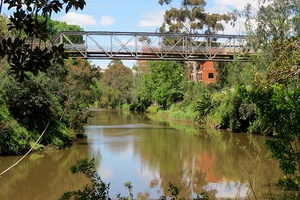
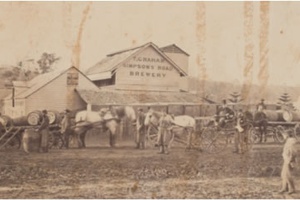
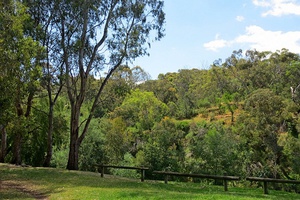
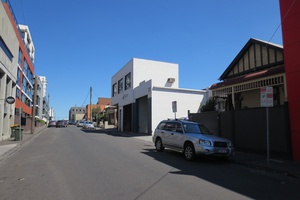
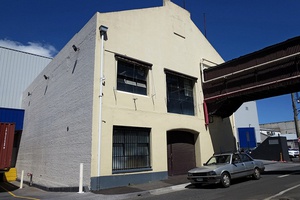
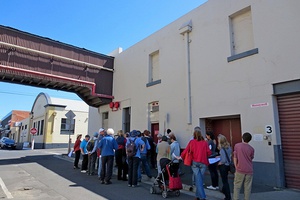
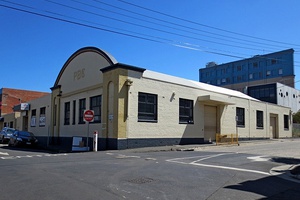
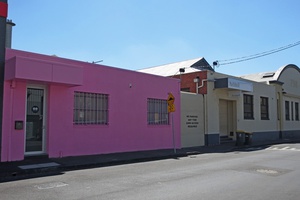
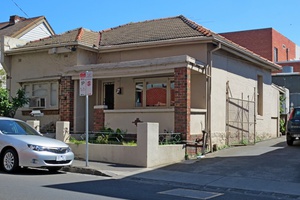


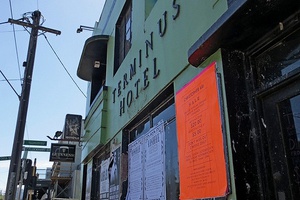
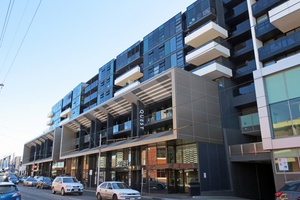
![13. [627] Victoria St. Brewery/Vinegar/Skipping Girl](/citizen/media/cache/91/80/9180246fe97e3838734988d4f518718c.jpg)
